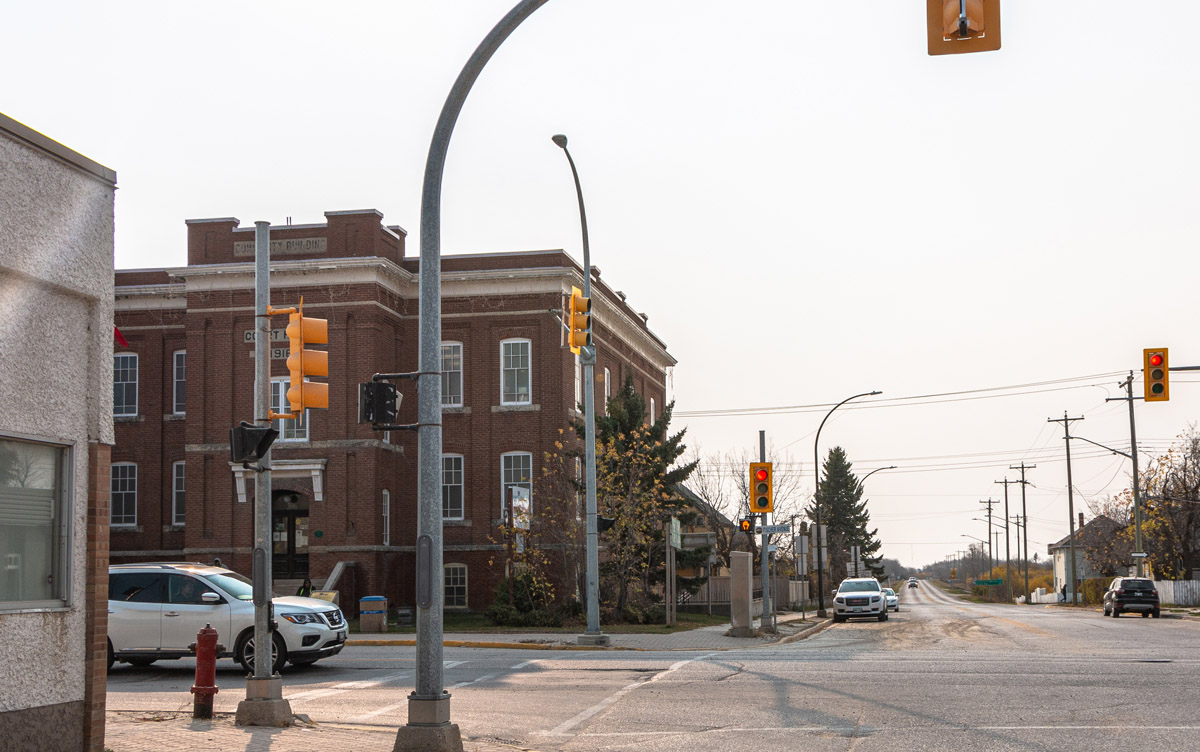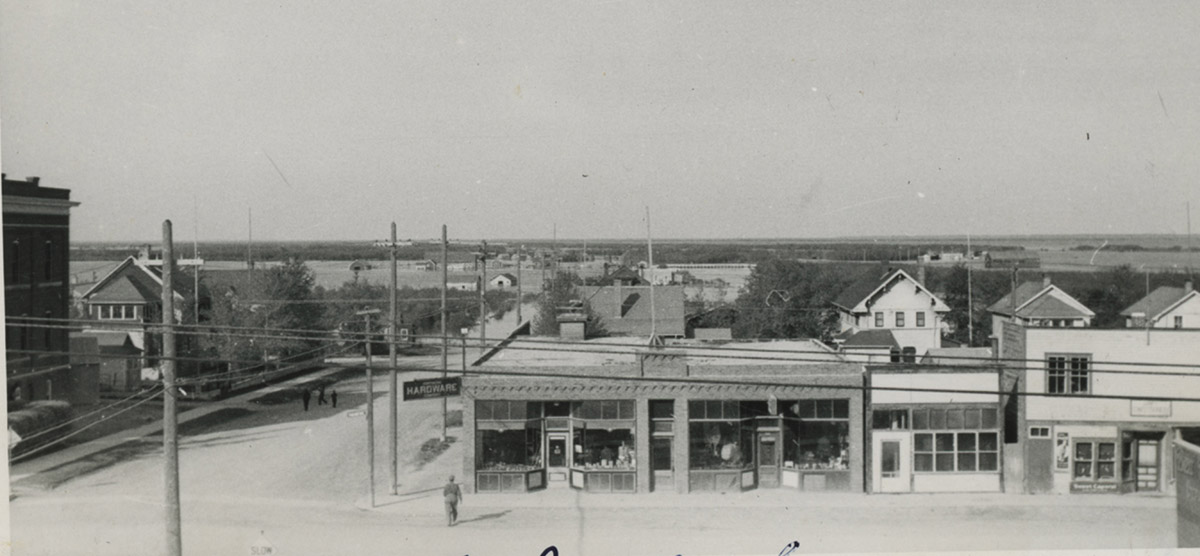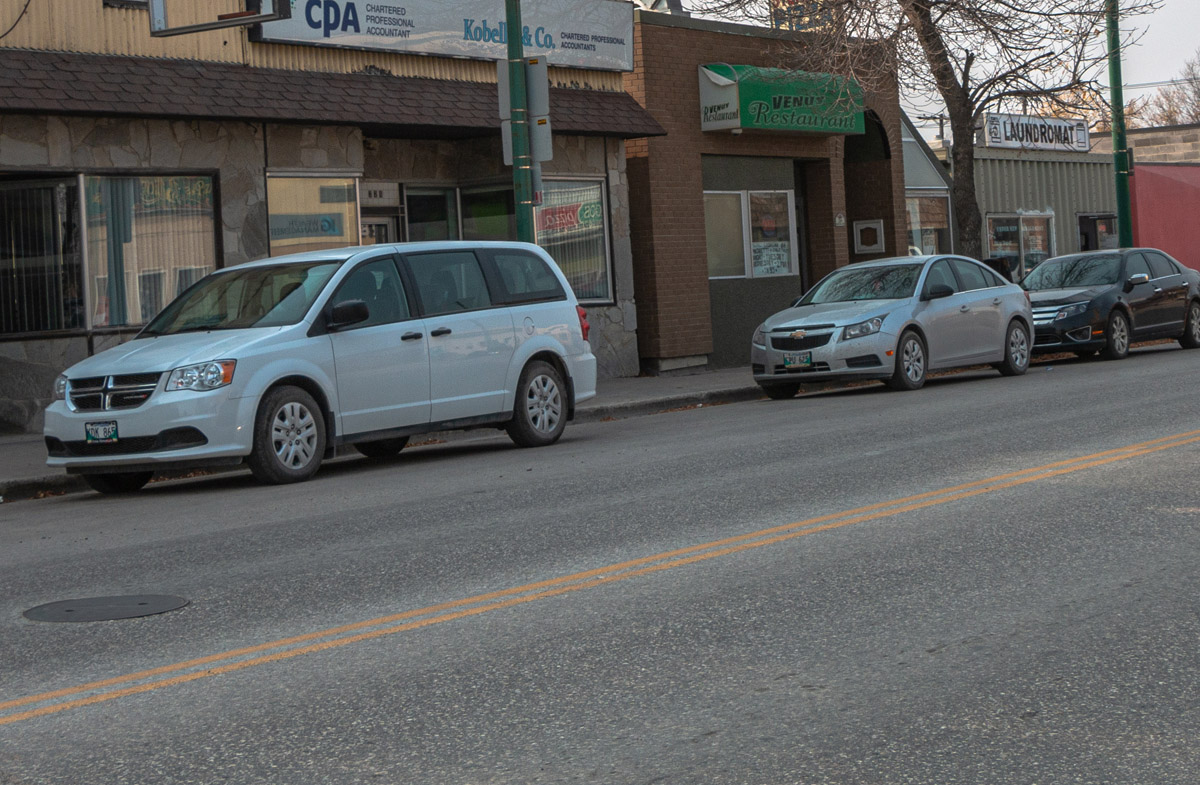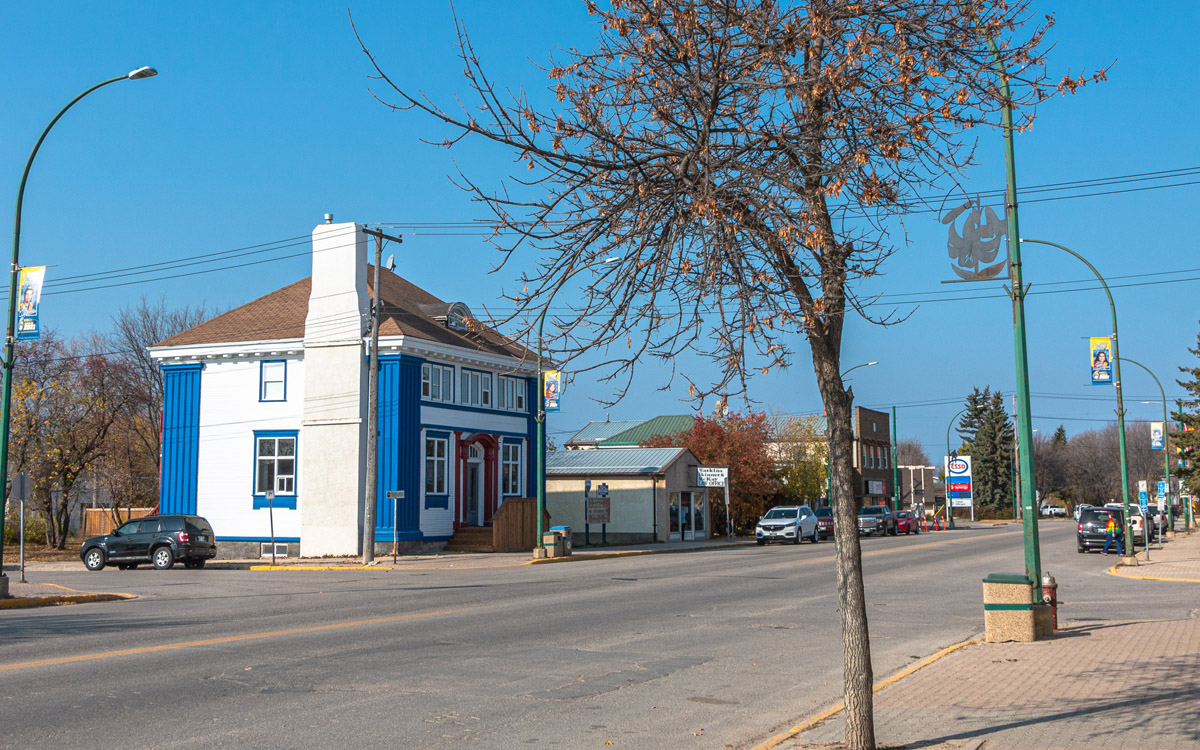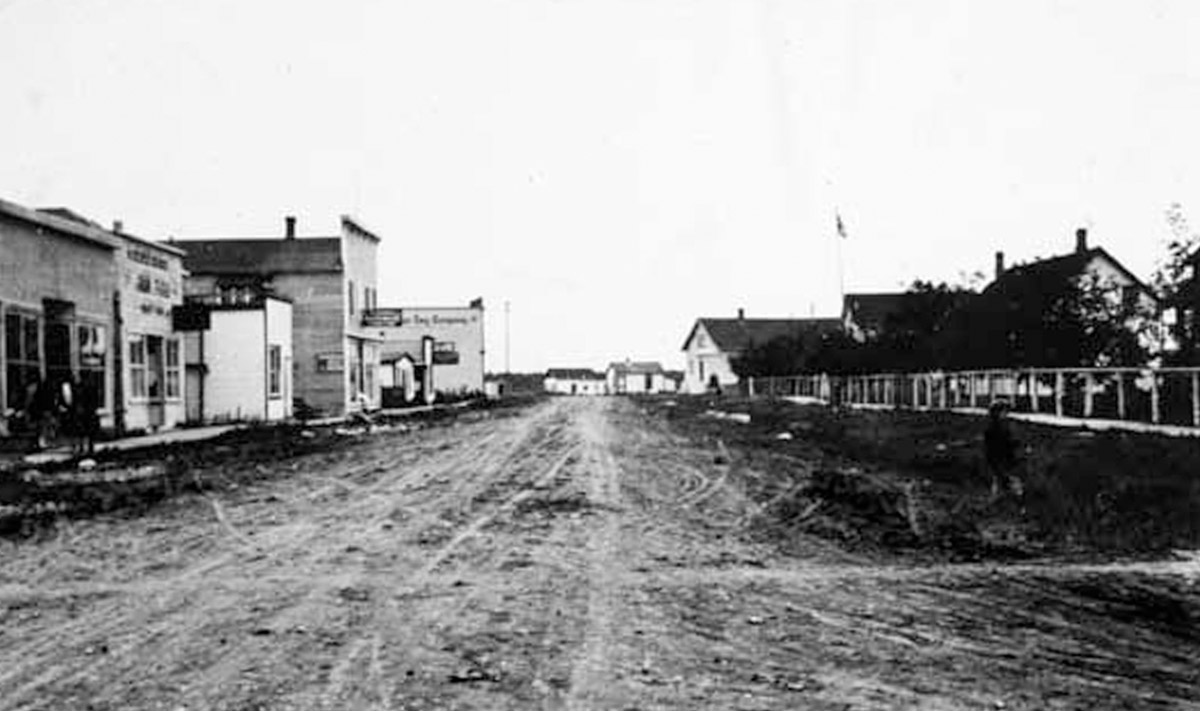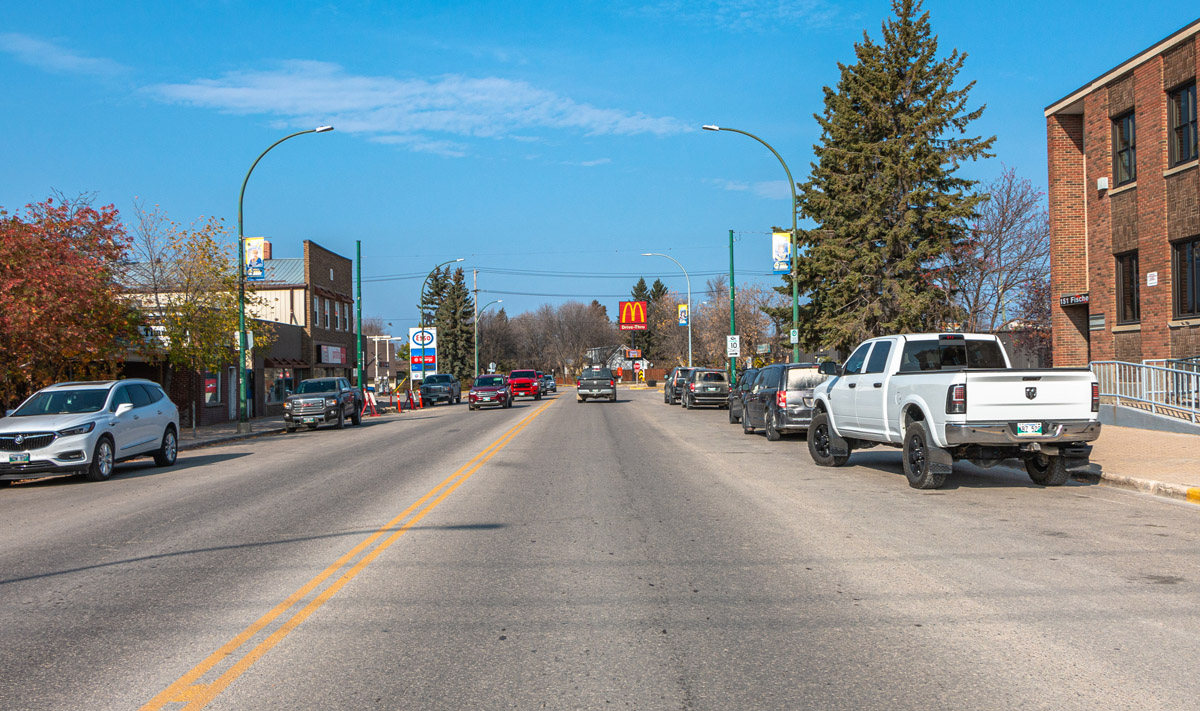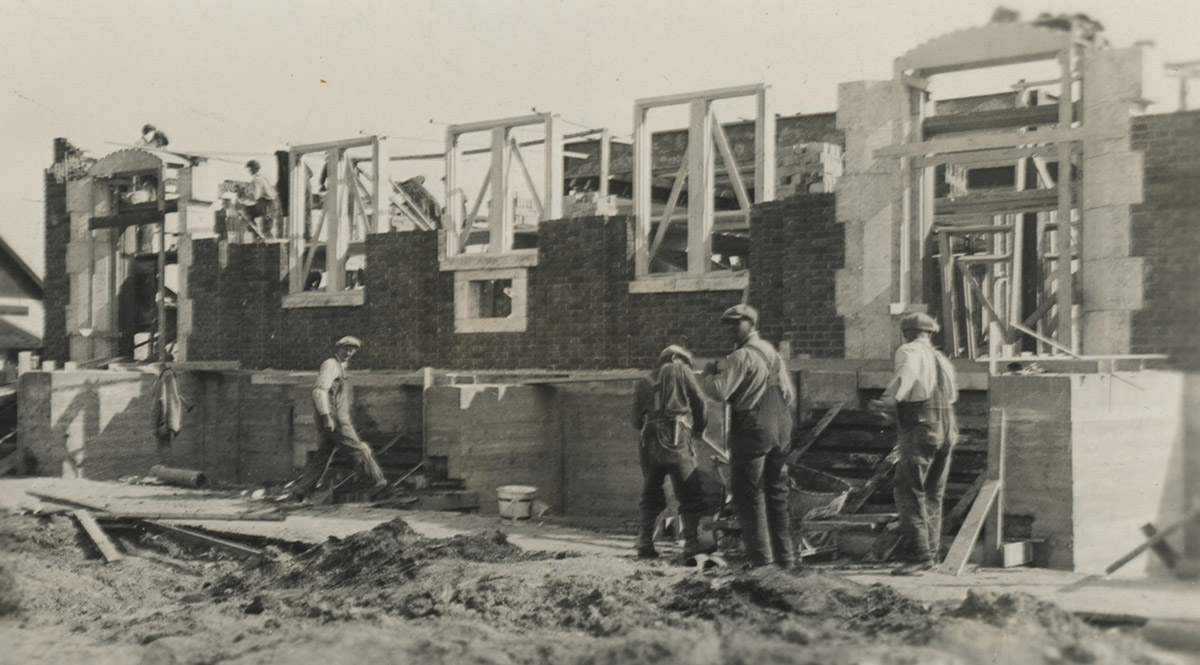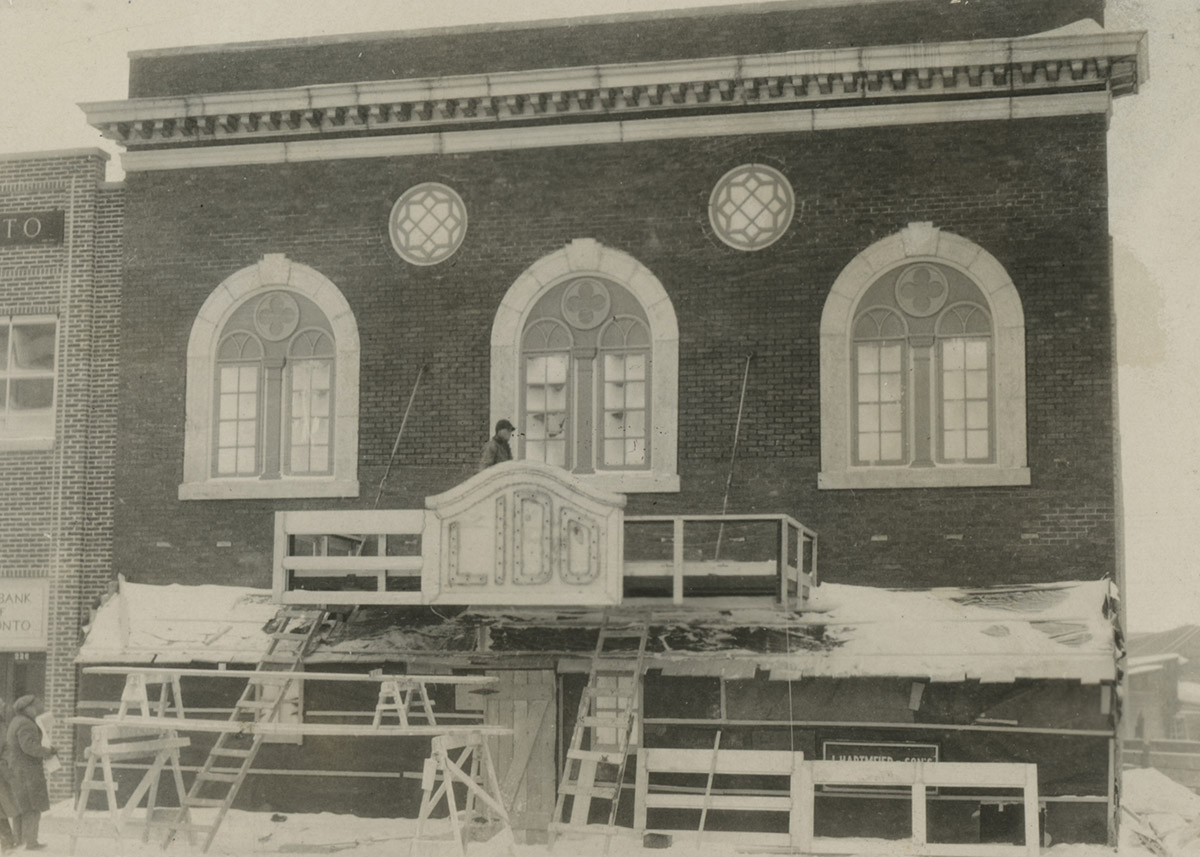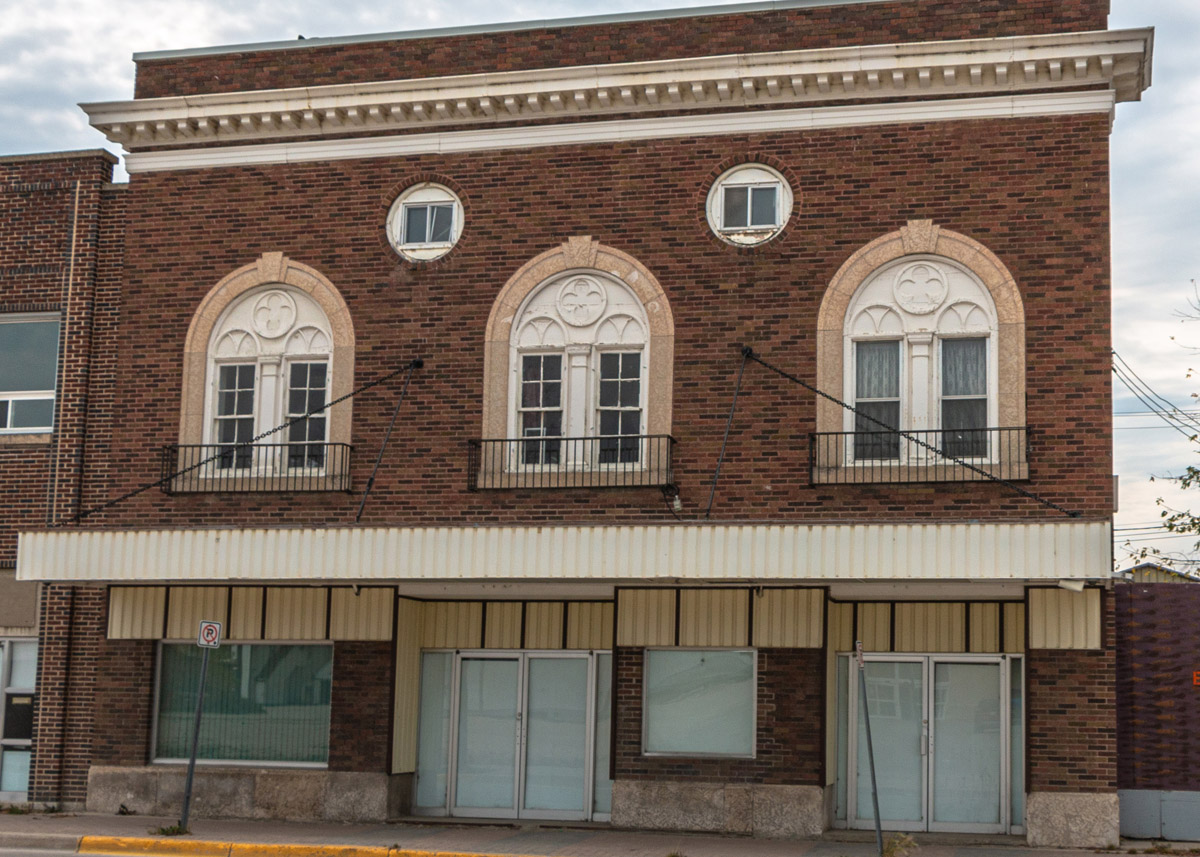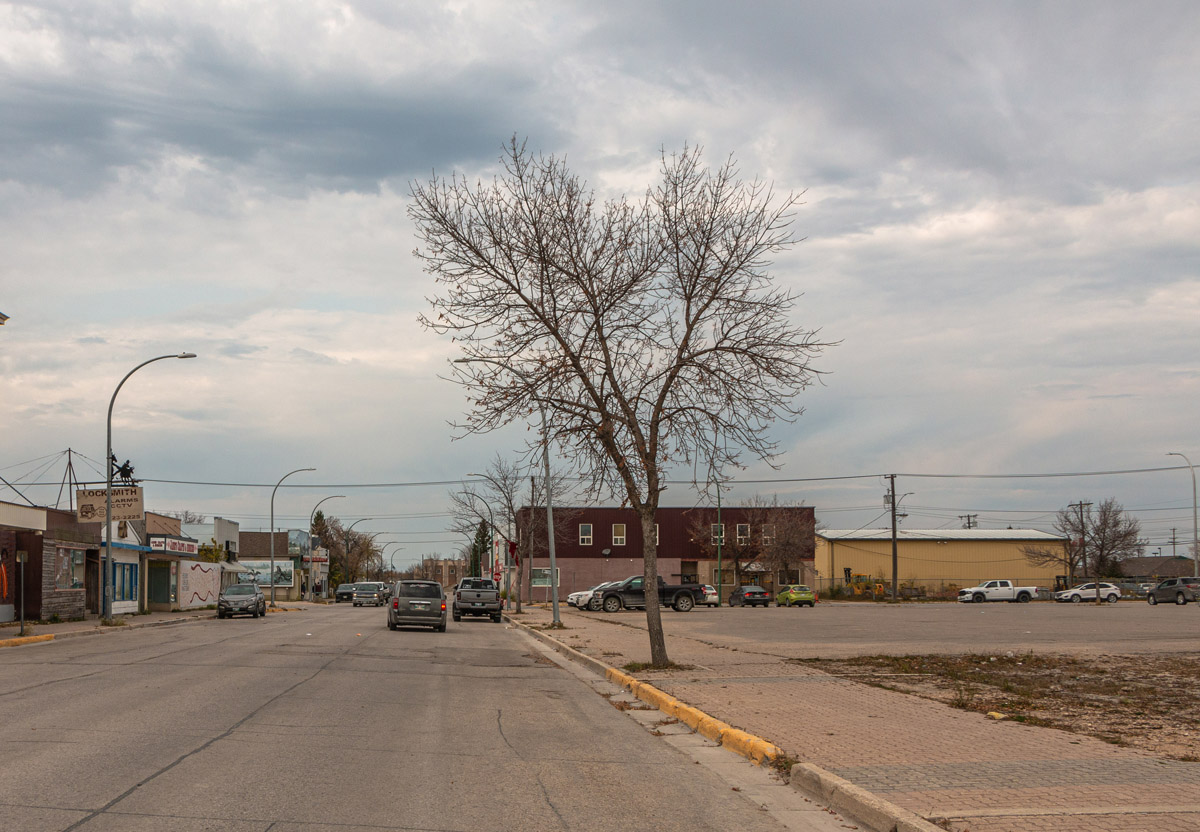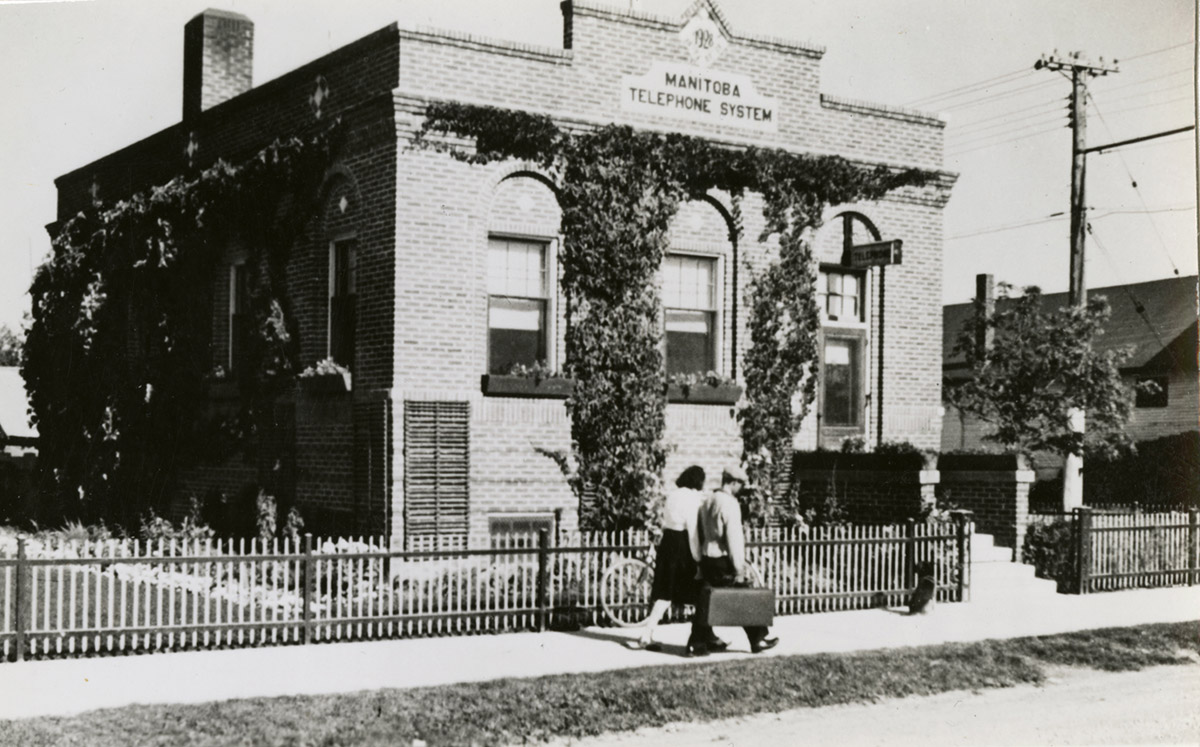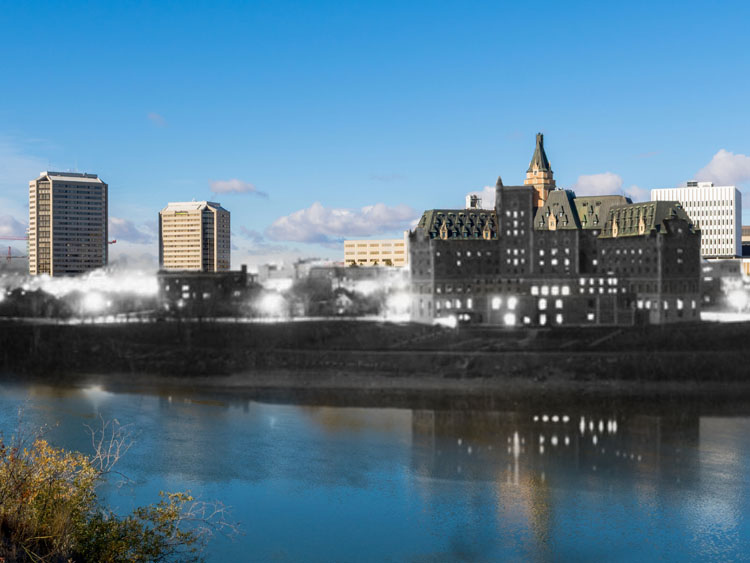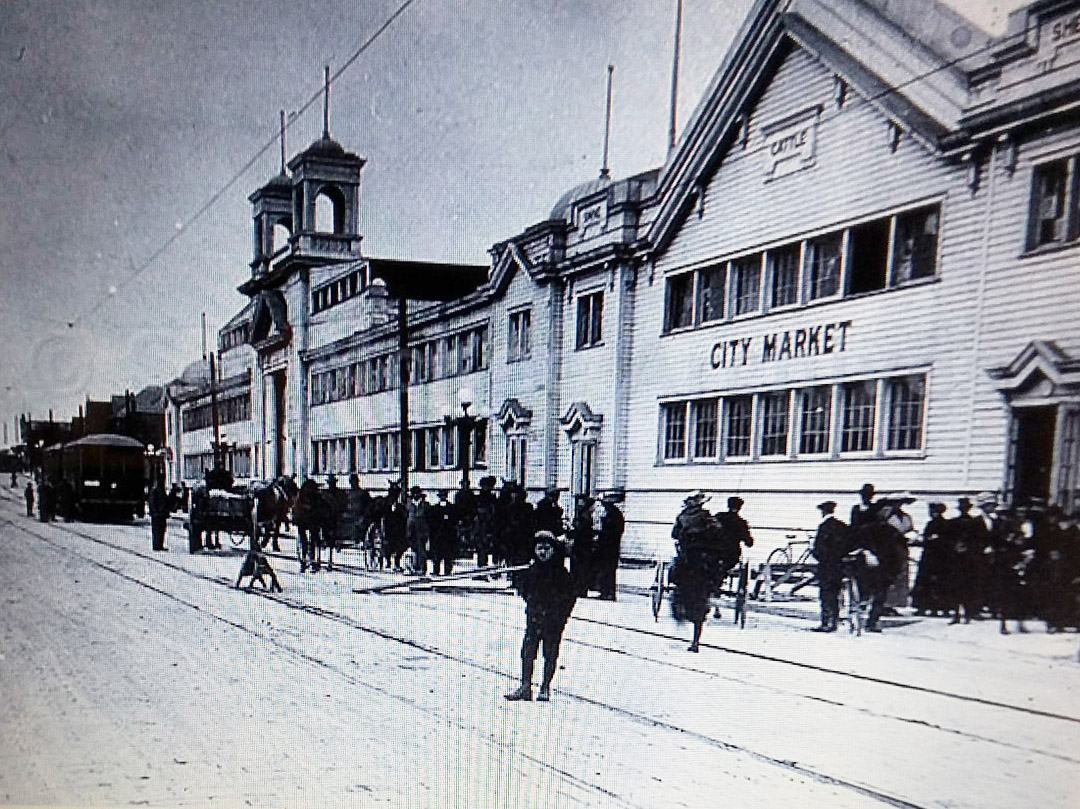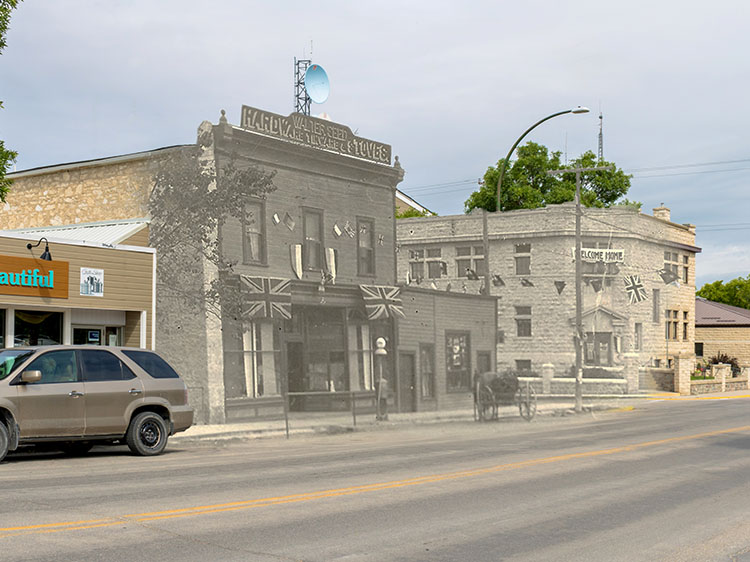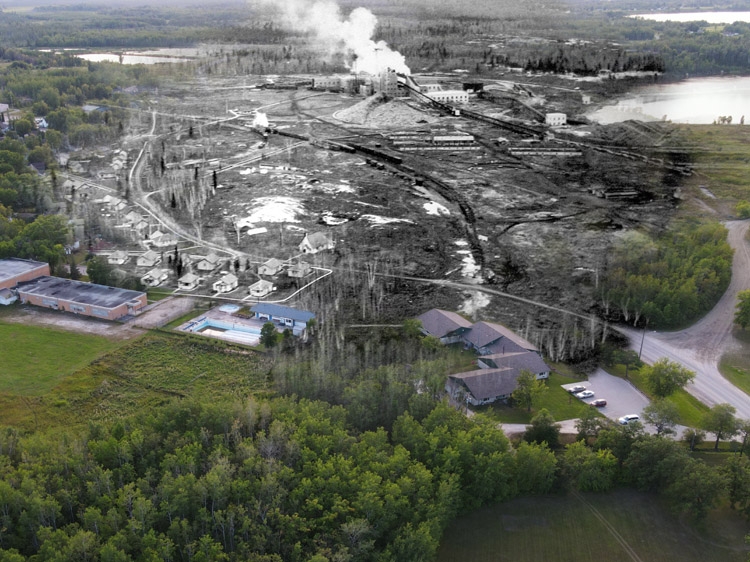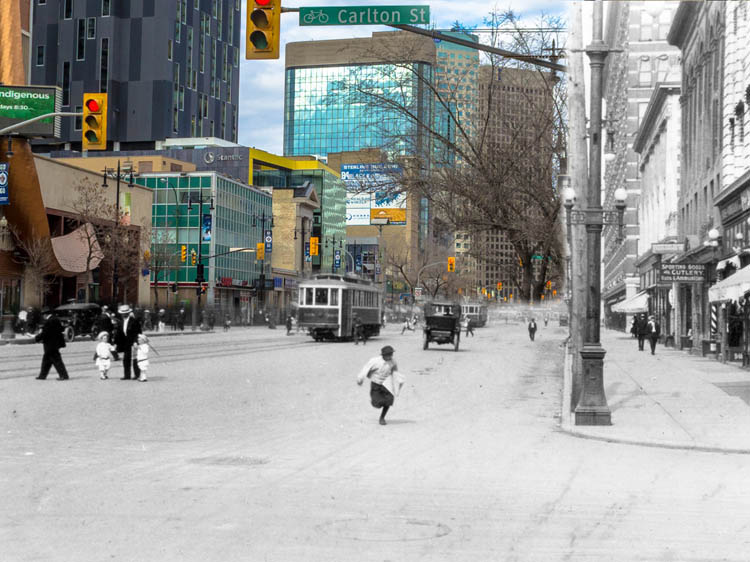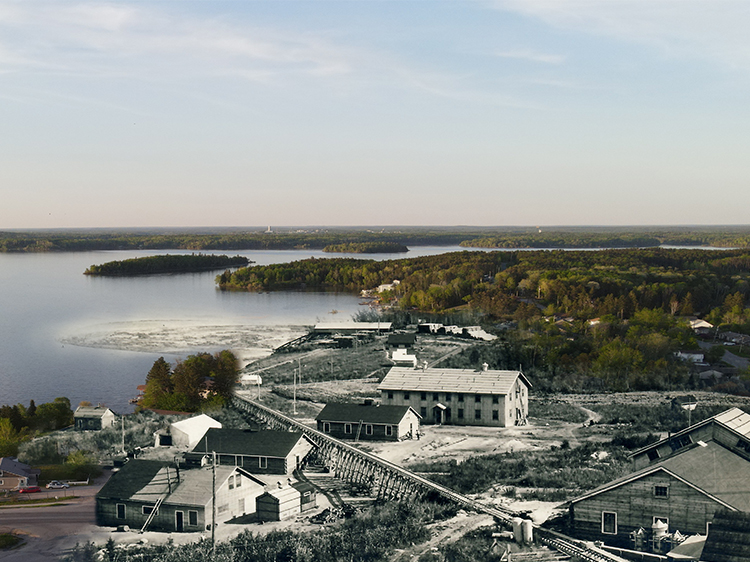Walking Tour
Life in The Pas
Fischer & Edwards Avenues
By Elyse Abma-Bouma
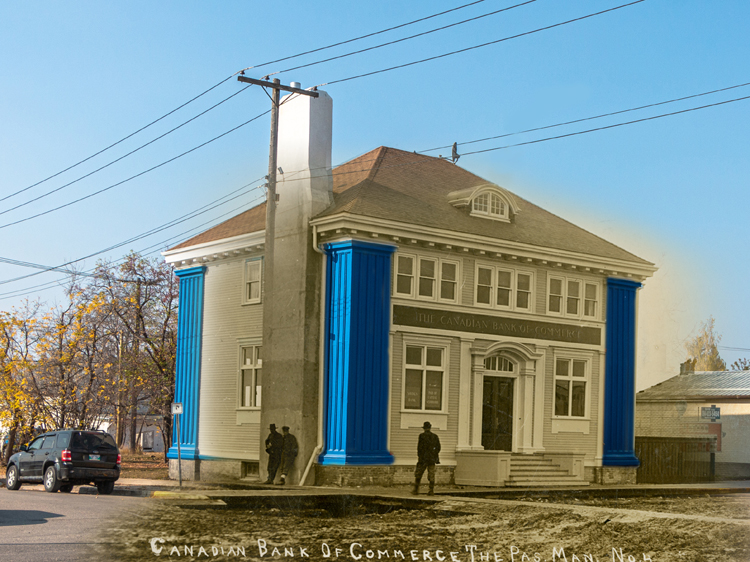
Sam Waller Museum Archives PP2018.3.2
The Pas began as a Cree camp at the confluence of the Carrot River, The Pas River and the Saskatchewan River. After the arrival of European settlers, it became established as a town that grew and expanded over the course of the late 19th and early 20th Century. In this tour we will explore the main streets of The Pas and learn the stories of the people, businesses, theatres, and public buildings that helped build this community.
Route:
This tour will take us through the original centre of The Pas. Starting at the Sam Waller Museum, we will travel north on Fischer Ave eventually turning east on 2nd Street towards Edwards Ave. We will then head down Edwards Ave eventually turning right onto 3rd Street to head back towards the museum completing the block.
The Sam Waller Museum virtual tours produced by On This Spot were made possible by the financial assistance of the Manitoba Arts Council. The project was initiated from the generous bequest of the estate of Marilyn Dupas for improvement to the Sam Waller Museum exhibits. The Friends of Sam Waller Museum are grateful for the funding they received to have these virtual tours developed to share the history of Sam Waller and the community of The Pas and surrounding area.
1. How Things Change
Sam Waller Museum Archives PP89.18.2
ca. 1920s
Built around 1916, this photo shows the brick structure that served as The Pas' courthouse, town hall, registry office, jail and community building. The courthouse is the oldest brick building still standing in Northern Manitoba. The community hall portion was located on the top floor with the courthouse and offices on the main floor and cells in the basement.1
* * *
The Pas (or Le Pas) was incorporated as a town in 1912, but that was hardly its beginning. Before settlement The Pas was a place where the Cree Indigenous peoples had an encampment. Often tales are told of the early European explorers and expeditions that passed through this area, such as the Franklin Expedition, Henry Kelsey and La Verendrye. However, it is the Opaskwayak Cree Nation who lived here everyday trapping beaver, hunting moose, and fishing.2
At the nexus of the rivers and the 'highway' of the Saskatchewan River, made this place was an ideal location for a trading outpost and fort. French fur traders reached this region in the mid 1700s and briefly established Fort Paskoyac at this site. Later on traders from the Hudson's Bay Company established their own post at The Pas to trade with the Cree, who were admired as proficient trappers. The HBC profited enormously from their hard work.3
HBC trade practices introduced a new form of social organization…[G]roups of four to five hunters began arriving at the posts under the guidance of a leader, known as uuchimaau to the Cree and 'captain' to the HBC managers. These leaders were not necessarily the best hunters, but rather adept at communicating with Europeans and valued for their trading skills by the other Cree hunters…The HBC managers often gave them European coats to distinguish them from other trading hunters as well as other gifts of food and clothes.4
Over the years the trading post expanded, adding an Anglican Mission to convert and assimilate the Cree peoples in the region. As European settlement started to ramp up in Canada, more settlers arrived in The Pas and in 1906 the Opaskwayak Cree Nation surrendered the townsite and were moved to the north bank of the river. With the displacement of the Indigenous population more settlers moved on to the south bank of the river and began establishing industries that exploited the region's rich resources of fish, timber, and minerals.5
2. Danger of the Elements
Sam Waller Museum Archives PP91.26.73
1948
In 1948 a flood surged over the banks of the river leaving miles of farmland covered in water. Located as it was at the confluence of three rivers, residents of The Pas knew that flooding was always a risk. However it was this particularly devastating flood that finally spurred discussions about drainage and reclamation of the river banks to prevent future flooding and preserve farmland.1
* * *
A further report and investigation of the region in 1924 revealed a slightly tempered outlook for agricultural promise:
[The Pas]...has great potential agricultural possibilities but the advisability of its construction is largely dependent in the needs for more farmland in the West, for which, at the present time, there is little demand.3
In the 1930s drought and economic downturn meant that many Canadians fell on hard times. In rare instances drought was of benefit for farmers with land that was usually wetter or swampy, The Pas was one such exception:
Although the government's ban on settlement [in The Pas region] remained in effect, unauthorized farms cropped up. The government was not apt to force people off the land with the advent of World War II, which brought a need for more agricultural production. Returning veterans looking for land also settled in the Pasquia region. 4
The flood of 1948 was one that would not soon be forgotten. Farmer Jack Fulmore remembered, "They were going around with a barge picking up cattle and getting them to high ground. It was quite a disaster and nobody got any crop in that year."5
Another farmer at the time, Curly Lapointe, discussed the flood in an interview in 2005:
I mean not to drown people but you had to start thinking to get the cows out, chickens, livestock, anything you had. Most of the machinery stayed right out there throughout the flood. There was about five feet of water all over throughout the Carrot River Valley. You couldn't see the fence posts. So dad moved the chickens up in the hayloft, some up the stairs in the house, second story, and Sue lived there. Surrounded by water she had a boat tied by the door and dad had built on Gordon Avenue, a temporary chicken coop and he moved the cows, there used to be stockyards there. That's where his cattle stayed plus they pastured all around the rail yard with getting runned over, pretty good eh? Everybody was very cooperative ya know, on the railroad. Watch out for that cow! And it lasted till late summer then everybody back that didn't move out of The Pas all together, moved back to their homes; start repairing the damage. Curled up floors right? And then life, by fall life was back to normal. But 1948 was the flood.6
Soon after the flood the Prairie Farm Rehabilitation Administration (PFRA) took over the initiative to protect and rehabilitate the area by building dykes, damns, and channels to prevent future disaster
3. The Trappers Festival
Sam Waller Museum Archives PP2000.6.15
ca. 1940s
This photo shows dogs and a sled on the street ready for the Trappers Festival in The Pas. The festival began as a race set up by Henry Fishman and Wilf Walkinshaw in 1947. The event highlighted trappers and their work through dog sled races and contests for the Fur King and Queen.1
* * *
With advancement in transportation technology the dogsled fell out of favour as a preferred transit system. However, the novelty did not wear off as dog sledding competitions and leisure sledding became popular in the 1940s and 50s. The Trappers Festival featured such races.
The success of…the first Northern Manitoba Trappers' Festival was noted nationwide. Fishman later noted "We were fortunate in having the press, radio and photographers give us ample publicity to help put the first festival over successfully."3
The Trappers Festival offered a little bit for everyone. The Miss Fur Queen competition was particularly of interest among many of the young women in The Pas:
These young ladies are judged on beauty, talent, poise and personality.4
Each Fur Queen would sell tickets and many were sponsored by local businesses receiving gifts and goods. A few years later, in 1955, the King Trapper contest was introduced as well:
The title is awarded to the fellow securing the most total points in all the various contests and sports events…Contests such as tree falling, wood cutting, canoe packing, flour packing, trap setting, muskrat skinning, tea boiling, bannock baking, moose calling, goose calling, and so on.5
Today the Trappers Festival has changed little more than adding a few events. People come from all around the country to compete and watch the competitions and indulge in treats and games.
4. Dirt & Mud
Sam Waller Museum Archives PP2000.6.3
ca. 1910s
In this early view of Fischer Avenue we can see the dirt street and wooden walks. Along the street you can see the Hudson's Bay Store, Shieff Bros, and the Canadian Bank of Commerce among others.
* * *
The low flows in the Red and Assiniboine rivers during 1930 and 1931 gave rise to objectionable odours owing to the continued pollution particularly by the discharge of sewage into them…As the condition of the revers grew worse in 1932 and 1923 [the Manitoba government[ approved of a scheme for the disposal of raw sewage.1
Though it was a stench in Winnipeg that would push the provincial government to act on sewage sanitation, eventually The Pas would reap the benefits as well. The tricky part, as it often is, was timing. It was the middle of the Great Depression and the economy was in a state of stagnation.2
Ultimately, it was decided that the sanitation project would be good for Winnipeg and Manitoba, stimulating the economy in hard times by providing jobs. Work commenced in July of 1935 with costs split between the federal and provincial governments
Municipalities such as The Pas, however, assumed the full cost of on-going operations after the installation of the sanitation system. They also paid for the land, administration and beginnings of the labour costs but all was well worth it to advance the sewer system in The Pas.3
5. The Hudson's Bay Company
Sam Waller Museum Archives PP2000.6.6
ca. 1900s
Looking back down Fischer Avenue we can see, again, the dirt roads and businesses from the early days of The Pas. S. Carroll Hardware and Furniture is among them as well as the Hudson's Bay Company Law offices.
* * *
Though the post was not located exactly where the town is presently, the Cree encampment on the banks of the Saskatchewan River was instrumental to fur trading in the region:
In 1856, the HBC did finally establish Fort Defiance at the future location of the Pas, and in the 1870s, it became a commercial centre when the Company took advantage of the deep water and natural harbour on the Saskatchewan River.2
Over the years The Pas became increasingly important for transfer and transportation of goods. Whereas many banks of rivers are shallow, the banks of The Pas had enough depth for steamboats to load up and transport on the Saskatchewan river, allowing navigation from Hudson's Bay in the east, deep into the prairies in the west.3
Many of the HBC's buildings stood for many years and were later repurposed as churches and shops, showing the adaptive and lasting legacy of the Hudson's Bay Company in The Pas.
6. The Post Office
Sam Waller Museum Archives PP85.5.4
1930s
Looking across Fischer Avenue we can see the post office which still stands. Six construction workers are laying bricks, and we can see the window frames have already been put in place. Plans for a post office here had been in the works for a few years prior, but progress stagnated during the economic downturn of the Great Depression. After much lobbying construction finally began in hopes it would stimulate employment and the local economy.1
* * *
Over the centuries mail has been delivered by a variety of means: early on many Indigneous peoples were hired to deliver letters and messages. More volume in letters meant that larger spaces were needed to carry mail so steamboats and trains were used. Eventually entire cars of trains and special vehicles were devoted to the postal service.3
One of The Pas' first postal workers was Violet Irene Guymer, but that was not her only occupation:
*Violet Irene Guymer … came to The Pas in 1910 with her husband, Daniel, and his brother Lawrence. The two men bought a team of horses and went into the draying and freighting business. No one is quite sure how the men got into undertaking."4
After Lawrence was killed in World War I, and the flu took Daniel's life, Violet was left a single mother and the town requested she take over the family embalming business started by her husband and brother-in-law.5
As well as caring for her children and embalming at night she continued to oversee the freighting and draying business. The rail line ended at The Pas. People and goods carrying on north went by sleigh and horse team in the winter and by boat in the summer. Her company with 27 teams handled a part of this traffic plus contracts to transport mail to and from the station and post office, and the liquor delivery contract.6
The post office still stands here today continuing to sort and deliver mail in The Pas. Though delivery people have come and gone over the decades Mrs. Guymer is still remembered for her multi-talented work as postal worker, undertaker, and transportation specialist.
7. Theatres and Entertainment
Sam Waller Museum Archives PP2.26.42
1929
The Lido Theatre opened its doors in 1930, featuring an 'atmospheric style', stage, dressing rooms, orchestra pit, and ample seating. Owned and operated by the Rivalin family since its inception, and is still owned by August Rivalin, the great grandson of founder Jean August Rivalin akak "Irish". We can still see many of the original features of the theatre including the brick facade and large upper floor windows, and the interior is largely original today as well. The Lido is one of the oldest atmospheric theatres still standing in Canada.1
* * *
A resident of The Pas, Helen Aunly Heatherington Herman, fondly remembers the Lido theatre:
Some of my childhood memories include what seemed like a long trek from Seventh St. down to Devon Park with a picnic lunch for a day at the wading pool and games around the old sun dial and bandstand. Also there were Saturday matinees for five cents at the Lido Theatre. The theatre was used for many social events requiring a stage, such as school plays, Remembrance Day services, and the Music Festival.3
A variety of performances graced the Lido Theatre over the decades including film, plays, musical performances, and opera:
Two very successful plays were produced in 1934-35. The first being 'Nothing but the Truth' and later the very successful operetta 'Princess Chrysanthemum'. The Lido Theatre was taken over for a week in each event…The beautiful principal actor's costumes were rented from Malabar Costume in Winnipeg. The operetta played for a week in the Lido drawing a full house with each performance. Those were hard times but they were also good times.4
The Lido Theatre has had great success over its long existence. You would be hard pressed to find a resident of The Pas who had not attended a matinee at the Lido.
8. Staying in The Pas
Sam Waller Museum Archives PP2011.5.278
ca. 1900s
It's difficult to imagine that this parking lot was once the site of one of the busiest hotels in The Pas. We can see the Opasquai Hotel and various other building that once stood on Edwards Avenue. Today the scene looks much different with new buildings, pavement and trees to replace the old structures, gravel and grass.
* * *
Before the arrival of Europeans the Cree people used the forest's resources to build shelters, cook food and gather.
The forest sheltered and supported both animals and people. Housing made from bark and poles shielded the people from cold, while the wood of the forest furnished fuel. Wood also made racks for drying meat or fish and supplied birch bark for canoes and frames for snowshoes, the two essential means of travel…The Pas area was an important spring rendezvous point for these Cree.1
Later on, one Dr. Larose's house was known as a place for staying upon arrival in The Pas:
As the Drs. residence on Fischer Avenue was a fairly spacious house, it also served as a meeting place on various occasions. The parlour was used as a Church for midnight mass at Christmas and on many Sundays; a downstairs spare room served as a hospital for many patients suffering with anything from broken and frozen legs to D.T.s, often it was the Missionary's Quarters and prior to the first hotel "Hotel De Pas" being built it received many visitors who had no place to go for a room.2
Whether a miner's tent, doctor's house, HBC bunkhouse or the Opasquai Hotel people have been laying their weary heads in The Pas for a long time.
9. Telephones and Communication
Sam Waller Museum Archives PP2002.23.79
1940s
A couple walk along the sidewalk in front of the Manitoba Telephone System building in the 1940s. The telephone office was beautified by creeper vines crawling up the facades. This building was once home to the telephone system of The Pas where young women would work day and night as operators connecting calls.
* * *
The story of the telephone really starts with the telegraph, which was created by Samuel Morse in 1837 about forty years prior to Alexander Graham Bell's telephone. The telegraph, much like the telephone would later, transmitted messages by way of wire resulting in speedy communication service Whereas the telegraph required a skilled interpreter the telephone allowed communication with those near and far in the comfort of your own living room.1
The telephone first appeared in Manitoba in 1878 but it would be some time before telephones appeared in people's homes and offices:
By [the 1880s] the public had stopped regarding the new instrument [the telephone] as a mere toy. Phones were being hooked up, but worked only in pairs. Something had to be done to make it possible to connect all these phones to each other. The answer was to have a telephone exchange.2
With the organization of the Manitoba Telephone Service company, The Pas eventually had its own centre for telecommunications in the region. Over the years many residents of The Pas have worked as operators for a time.
When leaving school in 1968 I went to work for the Manitoba Telephone System as a long distance operator. Over the course of seven years I worked my way through the ranks and became a staff supervisor. Through this experience many friendships were formed. (Judy Shirley Ann Brown)3
Though the telephone office no longer stands today as a result of advanced technology that now allows your phone to be held in your hand instead of attached to the wall, this spot is a reminder of how things shift and change.
10. Living in The Pas
Sam Waller Museum Archives PP2.26.30
1938
Dog Sleds on a snowy November day stopped on 3 Street in 1938. We can see a group gathered in front of the Paris Cafe in the background with the Northern Light Studio in the foreground. This photo was taken for the World's Arctic Fair in 1938.
* * *
Each of you, I'm sure, will find your own private memories tucked away in the pages of this book that identify most with your generation. I know I did. But there are some things here that are intergenerational that all of us who were raised here or spent a good portion of our life here will hold in our hearts; the Paris Cafe, the "old" rink, the Red Brick School…1
Reminisces of The Pas are full of imagery about Fischer and Edwards Avenues along with the rivers and steamboats around the town. The Pas resident Mr. Dembinsky reflected on his experience in a section of one of The Pas' histories:
As I look back on it now, I sort of see a kaleidoscope of memories. Dog teams tied up to the side of the store…[Ben Dembinsky Ltd. was] loaded with muskrat pelts and fox furs from Churchill and the Brochet area. I remember the Port Nelson Cafe…I see the Hudson Block is still standing…I remember The Pas as a good place to grow up in and to live in, and no matter where I live it will always remain that.2
As we've walked through the centre of The Pas we have seen both the old and new. We've seen some buildings that still remain from the early days of settlement. The story of The Pas is the story of its residents, from the Woodland Cree to settlers and immigrants still arriving today, each creating their own experience and contributing to the narrative of this town. What stories will you listen to and tell?
Endnotes
1. How Things Change
1. "The Pas: Walking Tour" courtesy of the Sam Waller Museum.
2. Lyon, D.M.. "The Pas." The Canadian Encyclopedia.
3. Lyon, D.M.. "The Pas." The Canadian Encyclopedia.
4. Cree Nation of Waskaganish, "The Fur Trade." online.
5. Lyon, D.M.. "The Pas." The Canadian Encyclopedia.
2. Danger of the Elements
1. "Farming in the Carrot Valley," Community Memories.3.
2. "Farming in the Carrot Valley," Community Memories.3.
3. "Farming in the Carrot Valley," Community Memories.3.
4. "Farming in the Carrot Valley," Community Memories.13.
5. "Farming in the Carrot Valley," Community Memories.19.
6. "Farming in the Carrot Valley," Community Memories.23.
3. The Trappers Festival
1. The Pas Historical Society, "The Pas: Gateway to Northern Manitoba." 126-27.
2. Meredith, Don H.. "Dogsledding." The Canadian Encyclopedia.
3. The Pas Historical Society, "The Pas: Gateway to Northern Manitoba." 127.
4. The Pas Historical Society, "The Pas: Gateway to Northern Manitoba." 127.
5. The Pas Historical Society, "The Pas: Gateway to Northern Manitoba." 127.
4. Dirt & Mud
1. Manitoba Historical Society, "Manitoba Organization: Greater Winnipeg Sanitary District." Online.
2. Manitoba Historical Society, "Manitoba Organization: Greater Winnipeg Sanitary District." Online.
3. Manitoba Historical Society, "Manitoba Organization: Greater Winnipeg Sanitary District." Online.
5. The Hudson's Bay Company
1. Ray, Arthur J.. "Hudson's Bay Company." The Canadian Encyclopedia. Online.
2. Manitoba Historical Society, "Timelinks: The Pas." Online
3. Manitoba Historical Society, "Timelinks: The Pas." Online.
6. The Post Office
1. Neustaedter, Laurel, The Pas 100 Years. 64.
2. Griffin, H. , and Mark Anderako. "Postal System." Online.
3. Griffin, H. , and Mark Anderako. "Postal System." Online.
4.The Pas Historical Society, The Pas: Gateway to Northern Manitoba. 273.
5.The Pas Historical Society, The Pas: Gateway to Northern Manitoba. 273.
6.The Pas Historical Society, The Pas: Gateway to Northern Manitoba. 274.
7. Theatres and Entertainment
1. "The Pas: Walking Tour" courtesy of the Sam Waller Museum.
2. Neustaedter, Laurel, The Pas 100 Years. 51.
3. The Pas Historical Society, The Pas: Gateway to Northern Manitoba. 285.
4. The Pas Historical Society, The Pas: Gateway to Northern Manitoba. 381.
8. Staying in The Pas
1. McCarthy, Martha, Harvesting the Northern Forest. 1.
2. Wilton, Sidney, "The Pas". 53.
9. Telephones and Communication
1. Babe, Robert E.. "Telephones." The Canadian Encyclopedia.Online.
2. Muir, Gilbert A., "A History of the Telephone in Manitoba." Online.
3. The Pas Historical Society, The Pas: Gateway to Northern Manitoba. 193.
10. Living in The Pas
1. Neustaedter, Laurel, The Pas 100 Years. 1.
2. The Pas Historical Society, The Pas: Gateway to Northern Manitoba. 144.
Bibliography
Babe, Robert E.. "Telephones." The Canadian Encyclopedia. Historica Canada. Article published December 03, 2012; Last Edited July 13, 2015.
Cree Nation of Waskaganish, "The Fur Trade." Accessed February 26, 2022. https://waskaganish.ca/the-fur-trade/
Griffin, H. , and Mark Anderako. "Postal System." The Canadian Encyclopedia. Historica Canada. Article published December 15, 2012; Last Edited May 25, 2016.
Lyon, D.M.. "The Pas." The Canadian Encyclopedia. Historica Canada. Article published September 11, 2012; Last Edited June 11, 2019.
Manitoba Historical Society, "Manitoba Organization: Greater Winnipeg Sanitary District." Accessed February 28, 2022. http://www.mhs.mb.ca/docs/organization/greaterwinnipegsanitarydistrict.shtml
Manitoba Historical Society, "Timelinks: The Pas." Accessed February 28, 2022. http://www.mhs.mb.ca/docs/features/timelinks/communities/thepas.shtml
McCarthy, Martha, Harvesting the Northern Forest: A History of the Forest Industry in The Pas and Area. The Pas History and Heritage Society Inc. (1997)
Meredith, Don H.. "Dogsledding." The Canadian Encyclopedia. Historica Canada. Article published February 07, 2006; Last Edited January 12, 2016.
Muir, Gilbert A., "A History of the Telephone in Manitoba." Manitoba Historical Society (1964-65). http://www.mhs.mb.ca/docs/transactions/3/telephone.shtml
Neustaedter, Laurel, The Pas 100 Years. Manitoba Local Histories Collection at Sam Waller Museum (2012)
Ray, Arthur J.. "Hudson's Bay Company." The Canadian Encyclopedia. Historica Canada. Article published April 02, 2009; Last Edited October 08, 2020.
Sam Waller Museum, "Farming in the Carrot Valley." Community Memories. Accessed February 25, 2022. https://www.communitystories.ca/v1/pm_v2.php?id=story_line&lg=English&fl=0&ex=765&sl=7771&pos=1&pf=1#
Sam Waller Museum, "The Pas: Walking Tour" courtesy of the Sam Waller Museum. 2022.
The Pas Historical Society, The Pas: Gateway to Northern Manitoba. The Pas, Manitoba (1983)
Wilton, Sidney, "The Pas". Manitoba Local History Collection. Accessed February 28, 2022. http://www.mb1870.org/localhistory/117%20-%20Wilton,%20The%20Pas.pdf






